Management Case Study: Analysis of Team Leadership and Conflicts
VerifiedAdded on 2023/04/25
|9
|2089
|151
Case Study
AI Summary
This case study examines a real-world scenario where a team leader struggled to manage a diverse team, leading to conflicts, lack of motivation, and ultimately, project failure. The assignment delves into the challenges of managing a team with varying cultural backgrounds and conflicting opinions, highlighting the impact on teamwork and project outcomes. The leader's ineffective communication and lack of leadership skills are identified as key contributors to the team's dysfunction. The case study explores the application of Tuckman's Group Development model, revealing the team's stagnation in the storming stage. It further explores potential solutions, such as team outings and improved communication strategies, and analyzes the factors that contributed to the team's challenges, including the leader's inability to foster trust, resolve conflicts, and motivate team members. The study concludes with a discussion of effective leadership techniques and the importance of diversity management in promoting teamwork and achieving project success.
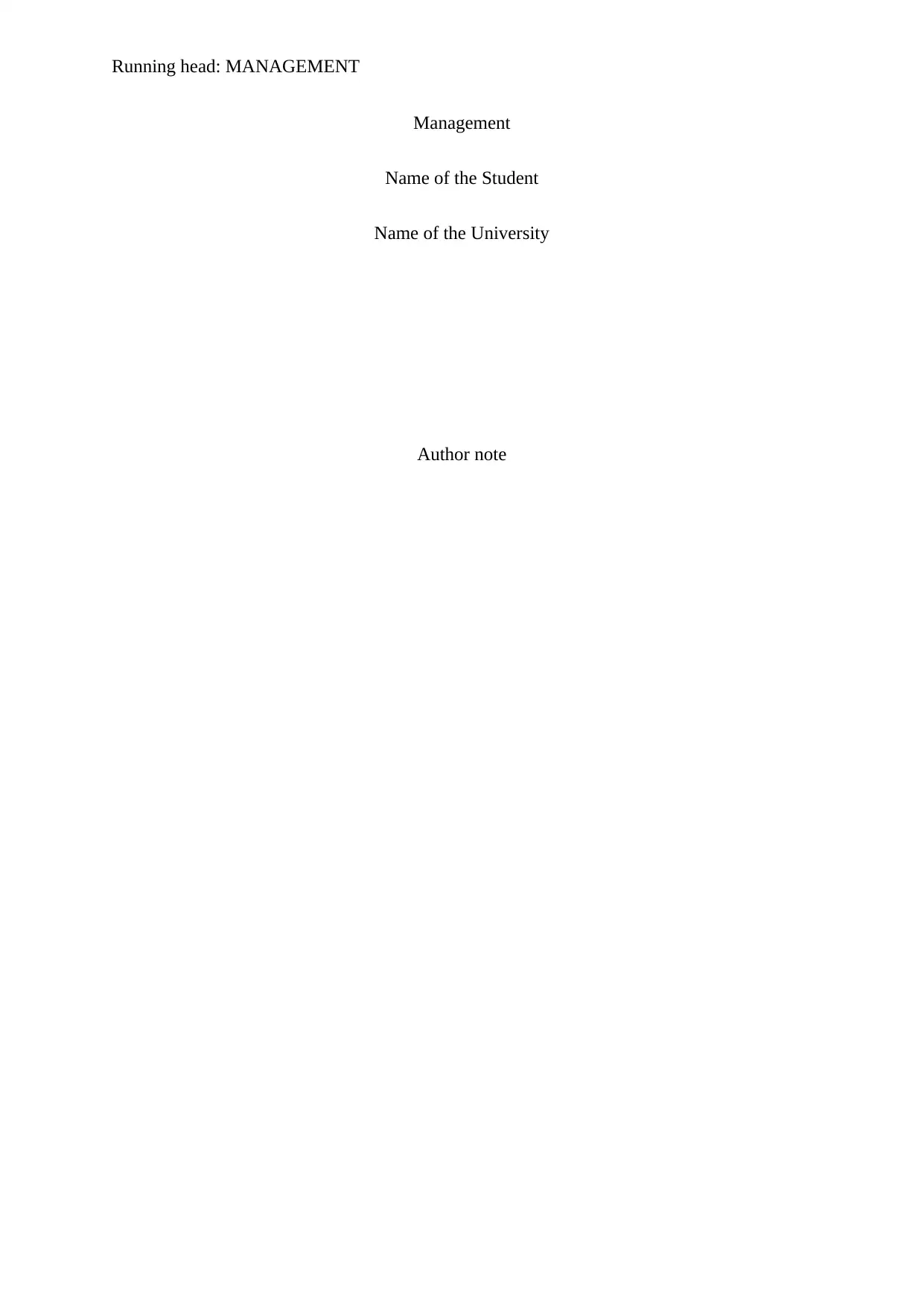
Running head: MANAGEMENT
Management
Name of the Student
Name of the University
Author note
Management
Name of the Student
Name of the University
Author note
Paraphrase This Document
Need a fresh take? Get an instant paraphrase of this document with our AI Paraphraser
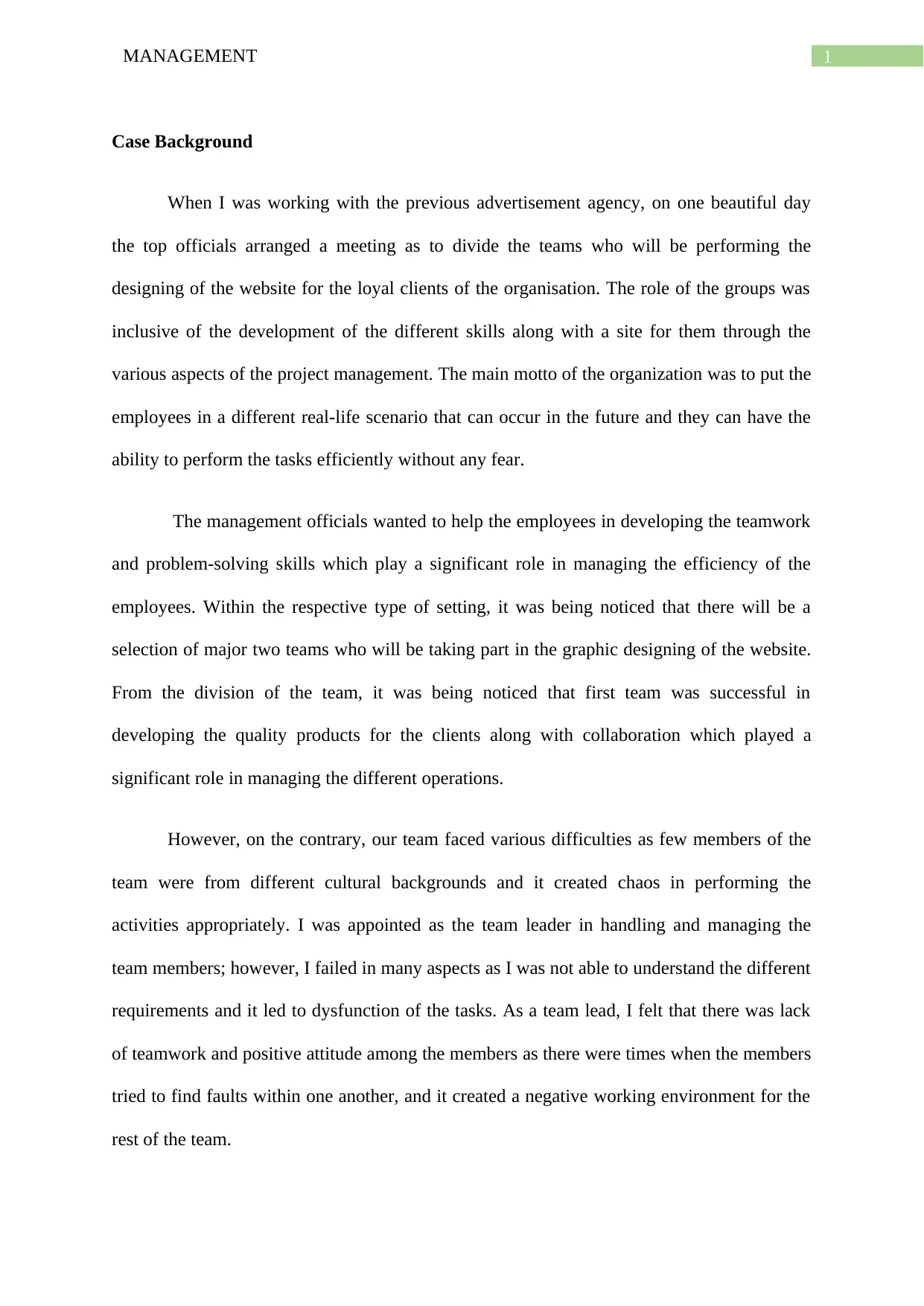
1MANAGEMENT
Case Background
When I was working with the previous advertisement agency, on one beautiful day
the top officials arranged a meeting as to divide the teams who will be performing the
designing of the website for the loyal clients of the organisation. The role of the groups was
inclusive of the development of the different skills along with a site for them through the
various aspects of the project management. The main motto of the organization was to put the
employees in a different real-life scenario that can occur in the future and they can have the
ability to perform the tasks efficiently without any fear.
The management officials wanted to help the employees in developing the teamwork
and problem-solving skills which play a significant role in managing the efficiency of the
employees. Within the respective type of setting, it was being noticed that there will be a
selection of major two teams who will be taking part in the graphic designing of the website.
From the division of the team, it was being noticed that first team was successful in
developing the quality products for the clients along with collaboration which played a
significant role in managing the different operations.
However, on the contrary, our team faced various difficulties as few members of the
team were from different cultural backgrounds and it created chaos in performing the
activities appropriately. I was appointed as the team leader in handling and managing the
team members; however, I failed in many aspects as I was not able to understand the different
requirements and it led to dysfunction of the tasks. As a team lead, I felt that there was lack
of teamwork and positive attitude among the members as there were times when the members
tried to find faults within one another, and it created a negative working environment for the
rest of the team.
Case Background
When I was working with the previous advertisement agency, on one beautiful day
the top officials arranged a meeting as to divide the teams who will be performing the
designing of the website for the loyal clients of the organisation. The role of the groups was
inclusive of the development of the different skills along with a site for them through the
various aspects of the project management. The main motto of the organization was to put the
employees in a different real-life scenario that can occur in the future and they can have the
ability to perform the tasks efficiently without any fear.
The management officials wanted to help the employees in developing the teamwork
and problem-solving skills which play a significant role in managing the efficiency of the
employees. Within the respective type of setting, it was being noticed that there will be a
selection of major two teams who will be taking part in the graphic designing of the website.
From the division of the team, it was being noticed that first team was successful in
developing the quality products for the clients along with collaboration which played a
significant role in managing the different operations.
However, on the contrary, our team faced various difficulties as few members of the
team were from different cultural backgrounds and it created chaos in performing the
activities appropriately. I was appointed as the team leader in handling and managing the
team members; however, I failed in many aspects as I was not able to understand the different
requirements and it led to dysfunction of the tasks. As a team lead, I felt that there was lack
of teamwork and positive attitude among the members as there were times when the members
tried to find faults within one another, and it created a negative working environment for the
rest of the team.
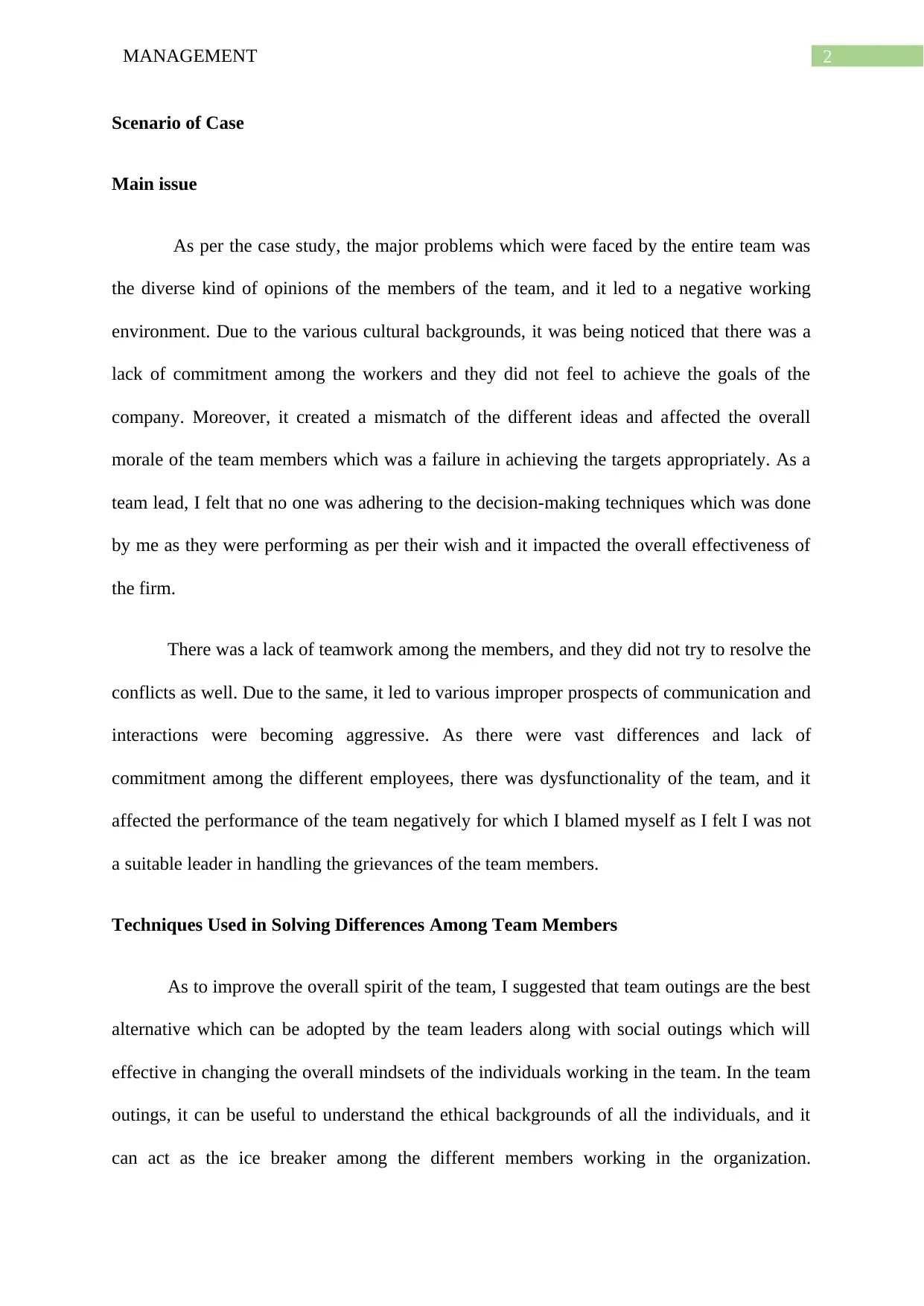
2MANAGEMENT
Scenario of Case
Main issue
As per the case study, the major problems which were faced by the entire team was
the diverse kind of opinions of the members of the team, and it led to a negative working
environment. Due to the various cultural backgrounds, it was being noticed that there was a
lack of commitment among the workers and they did not feel to achieve the goals of the
company. Moreover, it created a mismatch of the different ideas and affected the overall
morale of the team members which was a failure in achieving the targets appropriately. As a
team lead, I felt that no one was adhering to the decision-making techniques which was done
by me as they were performing as per their wish and it impacted the overall effectiveness of
the firm.
There was a lack of teamwork among the members, and they did not try to resolve the
conflicts as well. Due to the same, it led to various improper prospects of communication and
interactions were becoming aggressive. As there were vast differences and lack of
commitment among the different employees, there was dysfunctionality of the team, and it
affected the performance of the team negatively for which I blamed myself as I felt I was not
a suitable leader in handling the grievances of the team members.
Techniques Used in Solving Differences Among Team Members
As to improve the overall spirit of the team, I suggested that team outings are the best
alternative which can be adopted by the team leaders along with social outings which will
effective in changing the overall mindsets of the individuals working in the team. In the team
outings, it can be useful to understand the ethical backgrounds of all the individuals, and it
can act as the ice breaker among the different members working in the organization.
Scenario of Case
Main issue
As per the case study, the major problems which were faced by the entire team was
the diverse kind of opinions of the members of the team, and it led to a negative working
environment. Due to the various cultural backgrounds, it was being noticed that there was a
lack of commitment among the workers and they did not feel to achieve the goals of the
company. Moreover, it created a mismatch of the different ideas and affected the overall
morale of the team members which was a failure in achieving the targets appropriately. As a
team lead, I felt that no one was adhering to the decision-making techniques which was done
by me as they were performing as per their wish and it impacted the overall effectiveness of
the firm.
There was a lack of teamwork among the members, and they did not try to resolve the
conflicts as well. Due to the same, it led to various improper prospects of communication and
interactions were becoming aggressive. As there were vast differences and lack of
commitment among the different employees, there was dysfunctionality of the team, and it
affected the performance of the team negatively for which I blamed myself as I felt I was not
a suitable leader in handling the grievances of the team members.
Techniques Used in Solving Differences Among Team Members
As to improve the overall spirit of the team, I suggested that team outings are the best
alternative which can be adopted by the team leaders along with social outings which will
effective in changing the overall mindsets of the individuals working in the team. In the team
outings, it can be useful to understand the ethical backgrounds of all the individuals, and it
can act as the ice breaker among the different members working in the organization.
⊘ This is a preview!⊘
Do you want full access?
Subscribe today to unlock all pages.

Trusted by 1+ million students worldwide
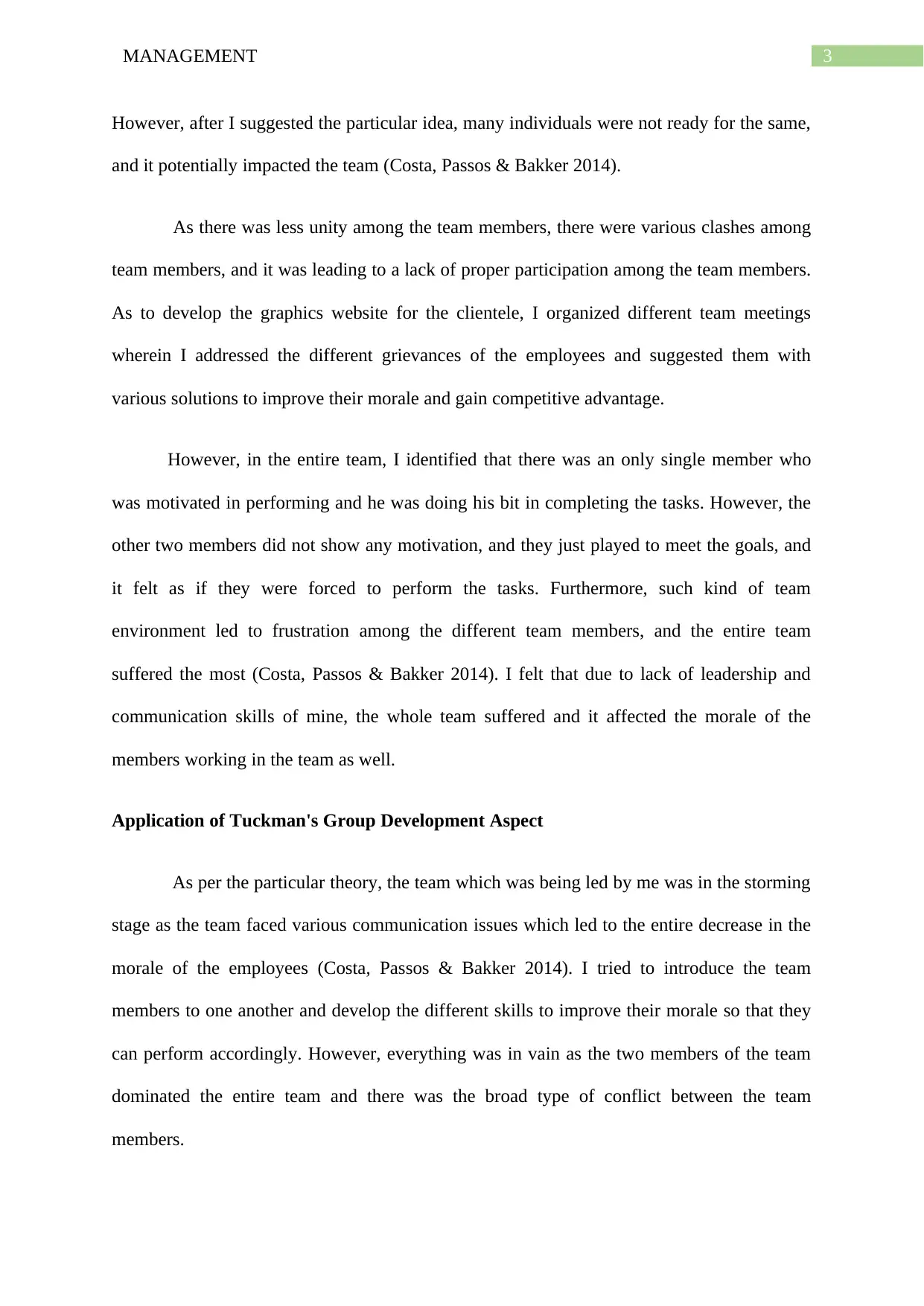
3MANAGEMENT
However, after I suggested the particular idea, many individuals were not ready for the same,
and it potentially impacted the team (Costa, Passos & Bakker 2014).
As there was less unity among the team members, there were various clashes among
team members, and it was leading to a lack of proper participation among the team members.
As to develop the graphics website for the clientele, I organized different team meetings
wherein I addressed the different grievances of the employees and suggested them with
various solutions to improve their morale and gain competitive advantage.
However, in the entire team, I identified that there was an only single member who
was motivated in performing and he was doing his bit in completing the tasks. However, the
other two members did not show any motivation, and they just played to meet the goals, and
it felt as if they were forced to perform the tasks. Furthermore, such kind of team
environment led to frustration among the different team members, and the entire team
suffered the most (Costa, Passos & Bakker 2014). I felt that due to lack of leadership and
communication skills of mine, the whole team suffered and it affected the morale of the
members working in the team as well.
Application of Tuckman's Group Development Aspect
As per the particular theory, the team which was being led by me was in the storming
stage as the team faced various communication issues which led to the entire decrease in the
morale of the employees (Costa, Passos & Bakker 2014). I tried to introduce the team
members to one another and develop the different skills to improve their morale so that they
can perform accordingly. However, everything was in vain as the two members of the team
dominated the entire team and there was the broad type of conflict between the team
members.
However, after I suggested the particular idea, many individuals were not ready for the same,
and it potentially impacted the team (Costa, Passos & Bakker 2014).
As there was less unity among the team members, there were various clashes among
team members, and it was leading to a lack of proper participation among the team members.
As to develop the graphics website for the clientele, I organized different team meetings
wherein I addressed the different grievances of the employees and suggested them with
various solutions to improve their morale and gain competitive advantage.
However, in the entire team, I identified that there was an only single member who
was motivated in performing and he was doing his bit in completing the tasks. However, the
other two members did not show any motivation, and they just played to meet the goals, and
it felt as if they were forced to perform the tasks. Furthermore, such kind of team
environment led to frustration among the different team members, and the entire team
suffered the most (Costa, Passos & Bakker 2014). I felt that due to lack of leadership and
communication skills of mine, the whole team suffered and it affected the morale of the
members working in the team as well.
Application of Tuckman's Group Development Aspect
As per the particular theory, the team which was being led by me was in the storming
stage as the team faced various communication issues which led to the entire decrease in the
morale of the employees (Costa, Passos & Bakker 2014). I tried to introduce the team
members to one another and develop the different skills to improve their morale so that they
can perform accordingly. However, everything was in vain as the two members of the team
dominated the entire team and there was the broad type of conflict between the team
members.
Paraphrase This Document
Need a fresh take? Get an instant paraphrase of this document with our AI Paraphraser
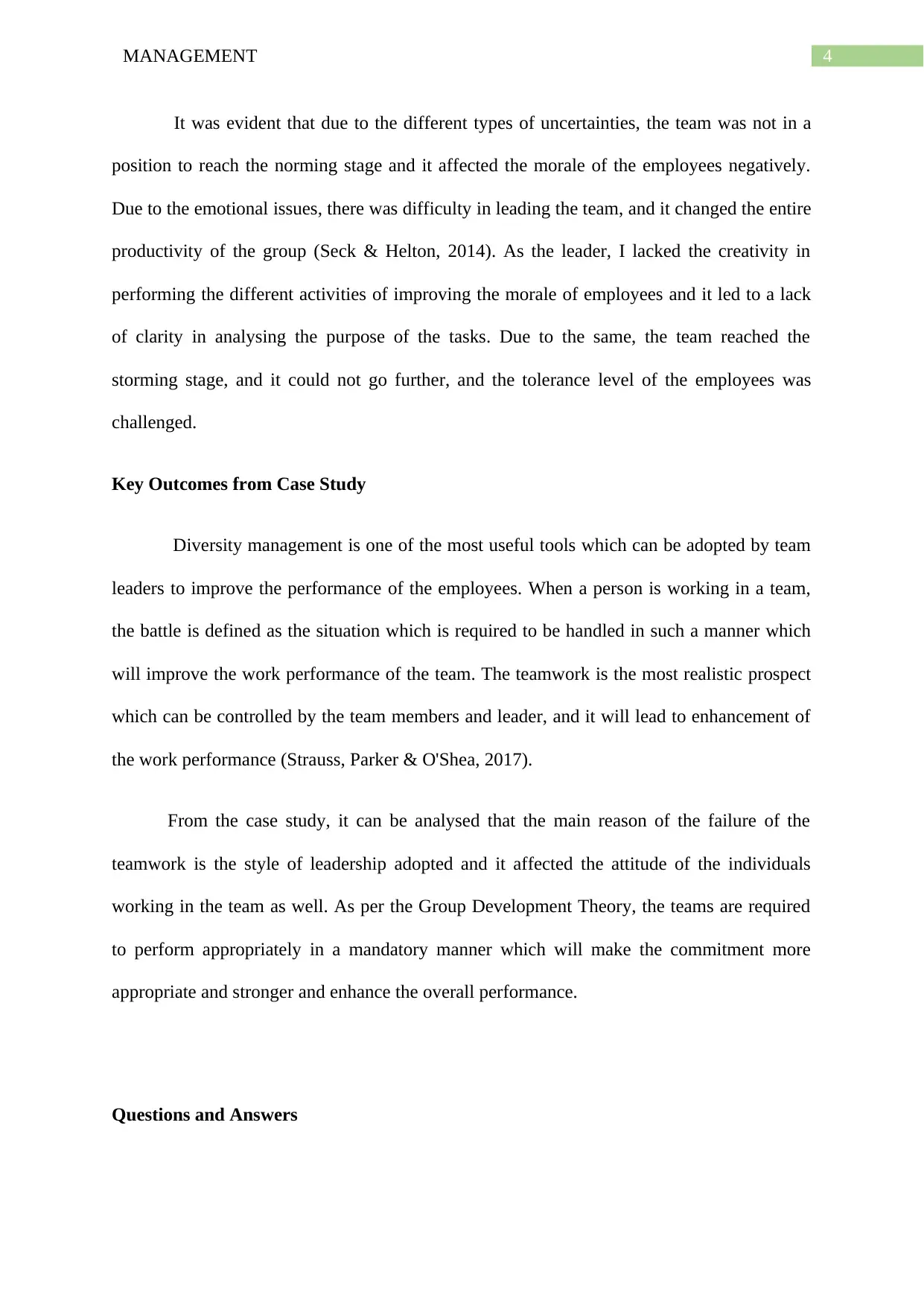
4MANAGEMENT
It was evident that due to the different types of uncertainties, the team was not in a
position to reach the norming stage and it affected the morale of the employees negatively.
Due to the emotional issues, there was difficulty in leading the team, and it changed the entire
productivity of the group (Seck & Helton, 2014). As the leader, I lacked the creativity in
performing the different activities of improving the morale of employees and it led to a lack
of clarity in analysing the purpose of the tasks. Due to the same, the team reached the
storming stage, and it could not go further, and the tolerance level of the employees was
challenged.
Key Outcomes from Case Study
Diversity management is one of the most useful tools which can be adopted by team
leaders to improve the performance of the employees. When a person is working in a team,
the battle is defined as the situation which is required to be handled in such a manner which
will improve the work performance of the team. The teamwork is the most realistic prospect
which can be controlled by the team members and leader, and it will lead to enhancement of
the work performance (Strauss, Parker & O'Shea, 2017).
From the case study, it can be analysed that the main reason of the failure of the
teamwork is the style of leadership adopted and it affected the attitude of the individuals
working in the team as well. As per the Group Development Theory, the teams are required
to perform appropriately in a mandatory manner which will make the commitment more
appropriate and stronger and enhance the overall performance.
Questions and Answers
It was evident that due to the different types of uncertainties, the team was not in a
position to reach the norming stage and it affected the morale of the employees negatively.
Due to the emotional issues, there was difficulty in leading the team, and it changed the entire
productivity of the group (Seck & Helton, 2014). As the leader, I lacked the creativity in
performing the different activities of improving the morale of employees and it led to a lack
of clarity in analysing the purpose of the tasks. Due to the same, the team reached the
storming stage, and it could not go further, and the tolerance level of the employees was
challenged.
Key Outcomes from Case Study
Diversity management is one of the most useful tools which can be adopted by team
leaders to improve the performance of the employees. When a person is working in a team,
the battle is defined as the situation which is required to be handled in such a manner which
will improve the work performance of the team. The teamwork is the most realistic prospect
which can be controlled by the team members and leader, and it will lead to enhancement of
the work performance (Strauss, Parker & O'Shea, 2017).
From the case study, it can be analysed that the main reason of the failure of the
teamwork is the style of leadership adopted and it affected the attitude of the individuals
working in the team as well. As per the Group Development Theory, the teams are required
to perform appropriately in a mandatory manner which will make the commitment more
appropriate and stronger and enhance the overall performance.
Questions and Answers
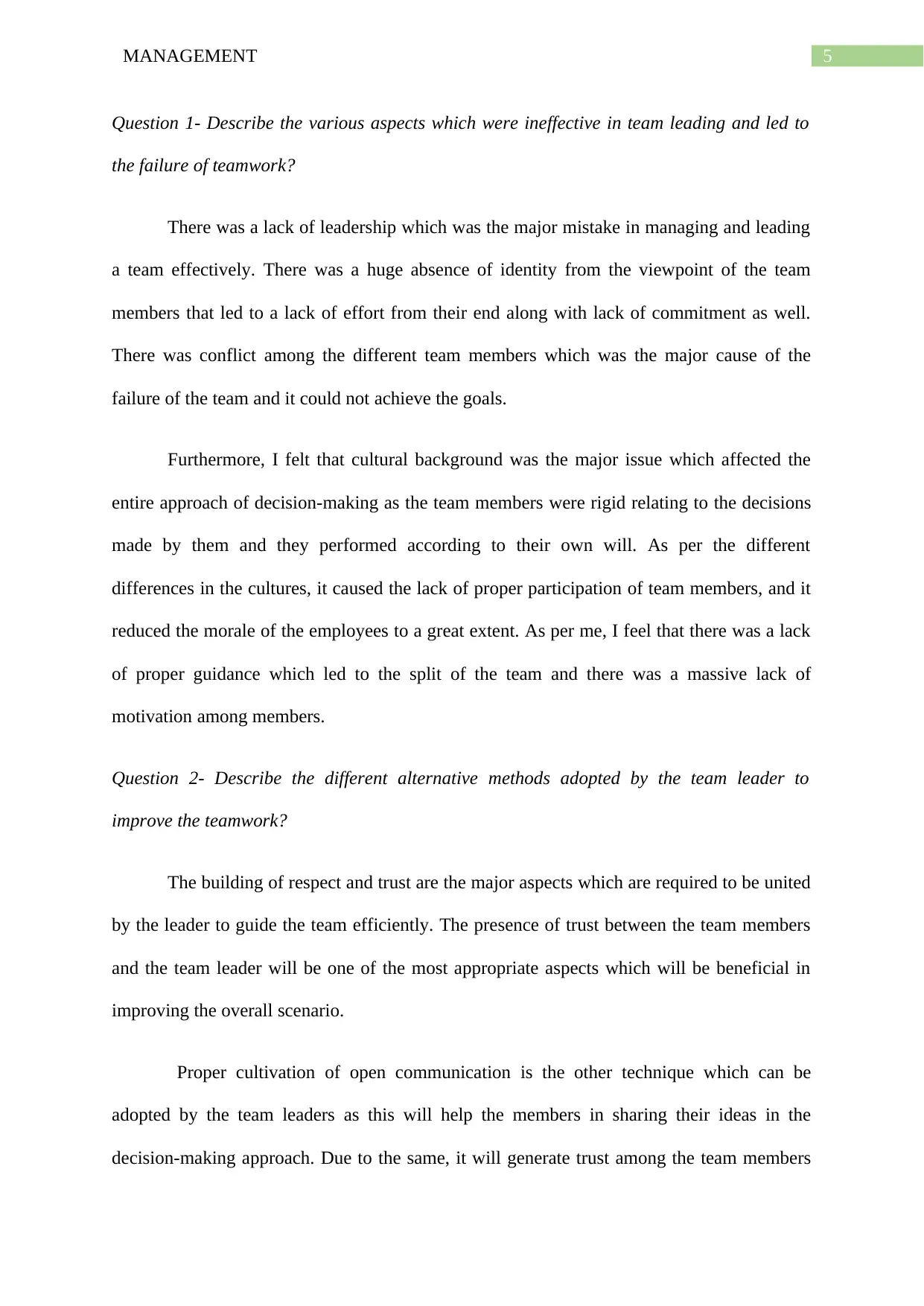
5MANAGEMENT
Question 1- Describe the various aspects which were ineffective in team leading and led to
the failure of teamwork?
There was a lack of leadership which was the major mistake in managing and leading
a team effectively. There was a huge absence of identity from the viewpoint of the team
members that led to a lack of effort from their end along with lack of commitment as well.
There was conflict among the different team members which was the major cause of the
failure of the team and it could not achieve the goals.
Furthermore, I felt that cultural background was the major issue which affected the
entire approach of decision-making as the team members were rigid relating to the decisions
made by them and they performed according to their own will. As per the different
differences in the cultures, it caused the lack of proper participation of team members, and it
reduced the morale of the employees to a great extent. As per me, I feel that there was a lack
of proper guidance which led to the split of the team and there was a massive lack of
motivation among members.
Question 2- Describe the different alternative methods adopted by the team leader to
improve the teamwork?
The building of respect and trust are the major aspects which are required to be united
by the leader to guide the team efficiently. The presence of trust between the team members
and the team leader will be one of the most appropriate aspects which will be beneficial in
improving the overall scenario.
Proper cultivation of open communication is the other technique which can be
adopted by the team leaders as this will help the members in sharing their ideas in the
decision-making approach. Due to the same, it will generate trust among the team members
Question 1- Describe the various aspects which were ineffective in team leading and led to
the failure of teamwork?
There was a lack of leadership which was the major mistake in managing and leading
a team effectively. There was a huge absence of identity from the viewpoint of the team
members that led to a lack of effort from their end along with lack of commitment as well.
There was conflict among the different team members which was the major cause of the
failure of the team and it could not achieve the goals.
Furthermore, I felt that cultural background was the major issue which affected the
entire approach of decision-making as the team members were rigid relating to the decisions
made by them and they performed according to their own will. As per the different
differences in the cultures, it caused the lack of proper participation of team members, and it
reduced the morale of the employees to a great extent. As per me, I feel that there was a lack
of proper guidance which led to the split of the team and there was a massive lack of
motivation among members.
Question 2- Describe the different alternative methods adopted by the team leader to
improve the teamwork?
The building of respect and trust are the major aspects which are required to be united
by the leader to guide the team efficiently. The presence of trust between the team members
and the team leader will be one of the most appropriate aspects which will be beneficial in
improving the overall scenario.
Proper cultivation of open communication is the other technique which can be
adopted by the team leaders as this will help the members in sharing their ideas in the
decision-making approach. Due to the same, it will generate trust among the team members
⊘ This is a preview!⊘
Do you want full access?
Subscribe today to unlock all pages.

Trusted by 1+ million students worldwide
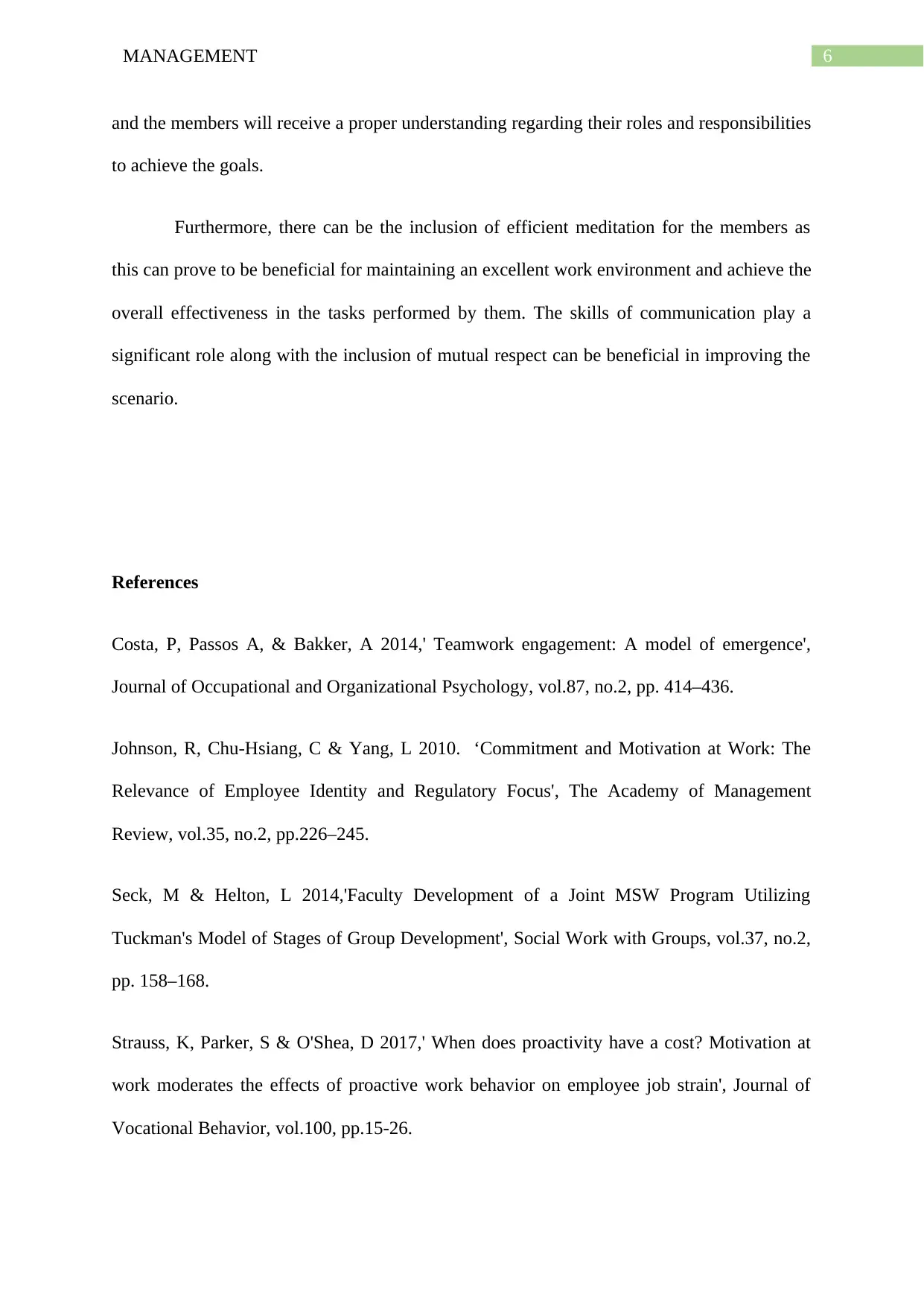
6MANAGEMENT
and the members will receive a proper understanding regarding their roles and responsibilities
to achieve the goals.
Furthermore, there can be the inclusion of efficient meditation for the members as
this can prove to be beneficial for maintaining an excellent work environment and achieve the
overall effectiveness in the tasks performed by them. The skills of communication play a
significant role along with the inclusion of mutual respect can be beneficial in improving the
scenario.
References
Costa, P, Passos A, & Bakker, A 2014,' Teamwork engagement: A model of emergence',
Journal of Occupational and Organizational Psychology, vol.87, no.2, pp. 414–436.
Johnson, R, Chu-Hsiang, C & Yang, L 2010. ‘Commitment and Motivation at Work: The
Relevance of Employee Identity and Regulatory Focus', The Academy of Management
Review, vol.35, no.2, pp.226–245.
Seck, M & Helton, L 2014,'Faculty Development of a Joint MSW Program Utilizing
Tuckman's Model of Stages of Group Development', Social Work with Groups, vol.37, no.2,
pp. 158–168.
Strauss, K, Parker, S & O'Shea, D 2017,' When does proactivity have a cost? Motivation at
work moderates the effects of proactive work behavior on employee job strain', Journal of
Vocational Behavior, vol.100, pp.15-26.
and the members will receive a proper understanding regarding their roles and responsibilities
to achieve the goals.
Furthermore, there can be the inclusion of efficient meditation for the members as
this can prove to be beneficial for maintaining an excellent work environment and achieve the
overall effectiveness in the tasks performed by them. The skills of communication play a
significant role along with the inclusion of mutual respect can be beneficial in improving the
scenario.
References
Costa, P, Passos A, & Bakker, A 2014,' Teamwork engagement: A model of emergence',
Journal of Occupational and Organizational Psychology, vol.87, no.2, pp. 414–436.
Johnson, R, Chu-Hsiang, C & Yang, L 2010. ‘Commitment and Motivation at Work: The
Relevance of Employee Identity and Regulatory Focus', The Academy of Management
Review, vol.35, no.2, pp.226–245.
Seck, M & Helton, L 2014,'Faculty Development of a Joint MSW Program Utilizing
Tuckman's Model of Stages of Group Development', Social Work with Groups, vol.37, no.2,
pp. 158–168.
Strauss, K, Parker, S & O'Shea, D 2017,' When does proactivity have a cost? Motivation at
work moderates the effects of proactive work behavior on employee job strain', Journal of
Vocational Behavior, vol.100, pp.15-26.
Paraphrase This Document
Need a fresh take? Get an instant paraphrase of this document with our AI Paraphraser
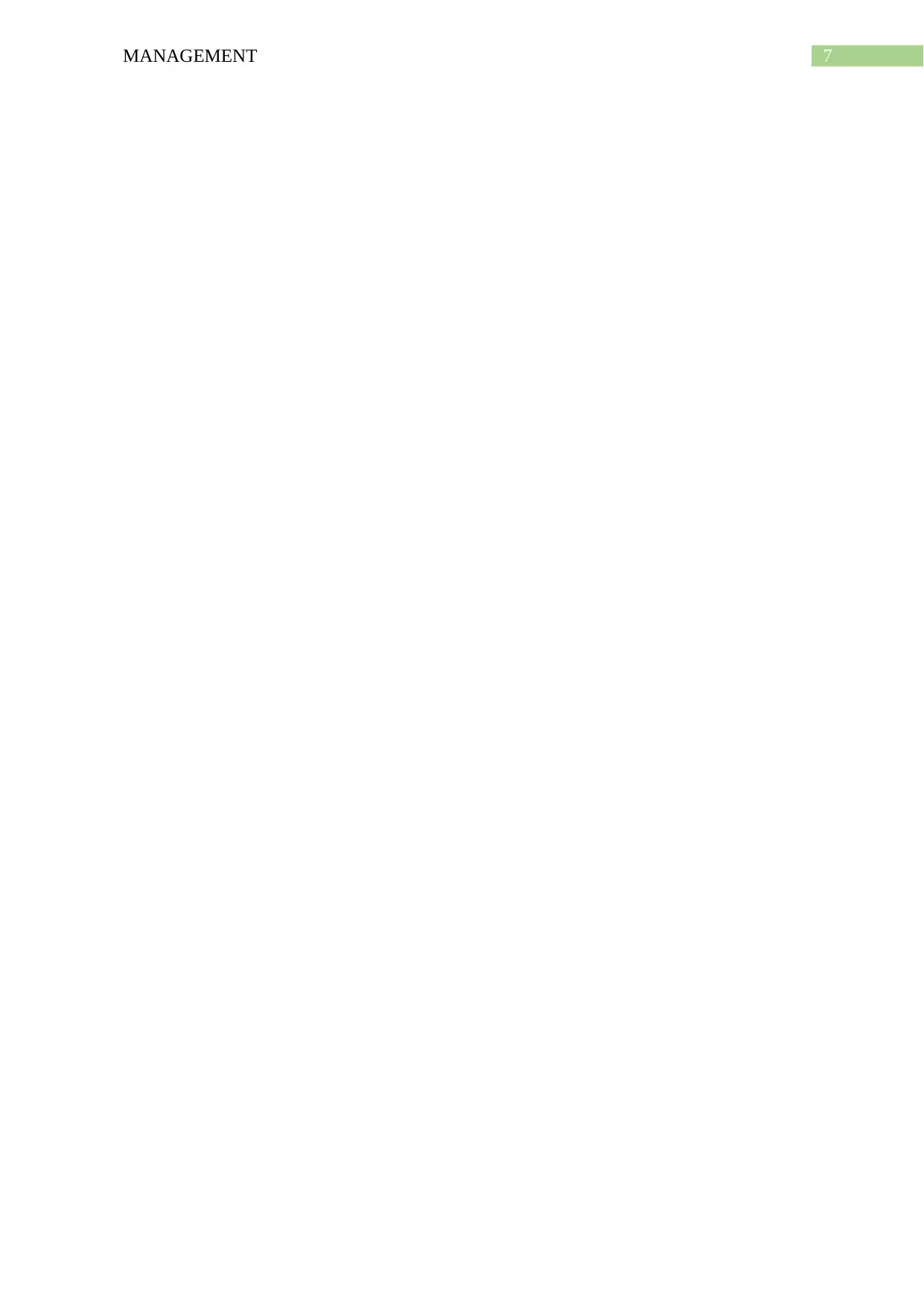
7MANAGEMENT
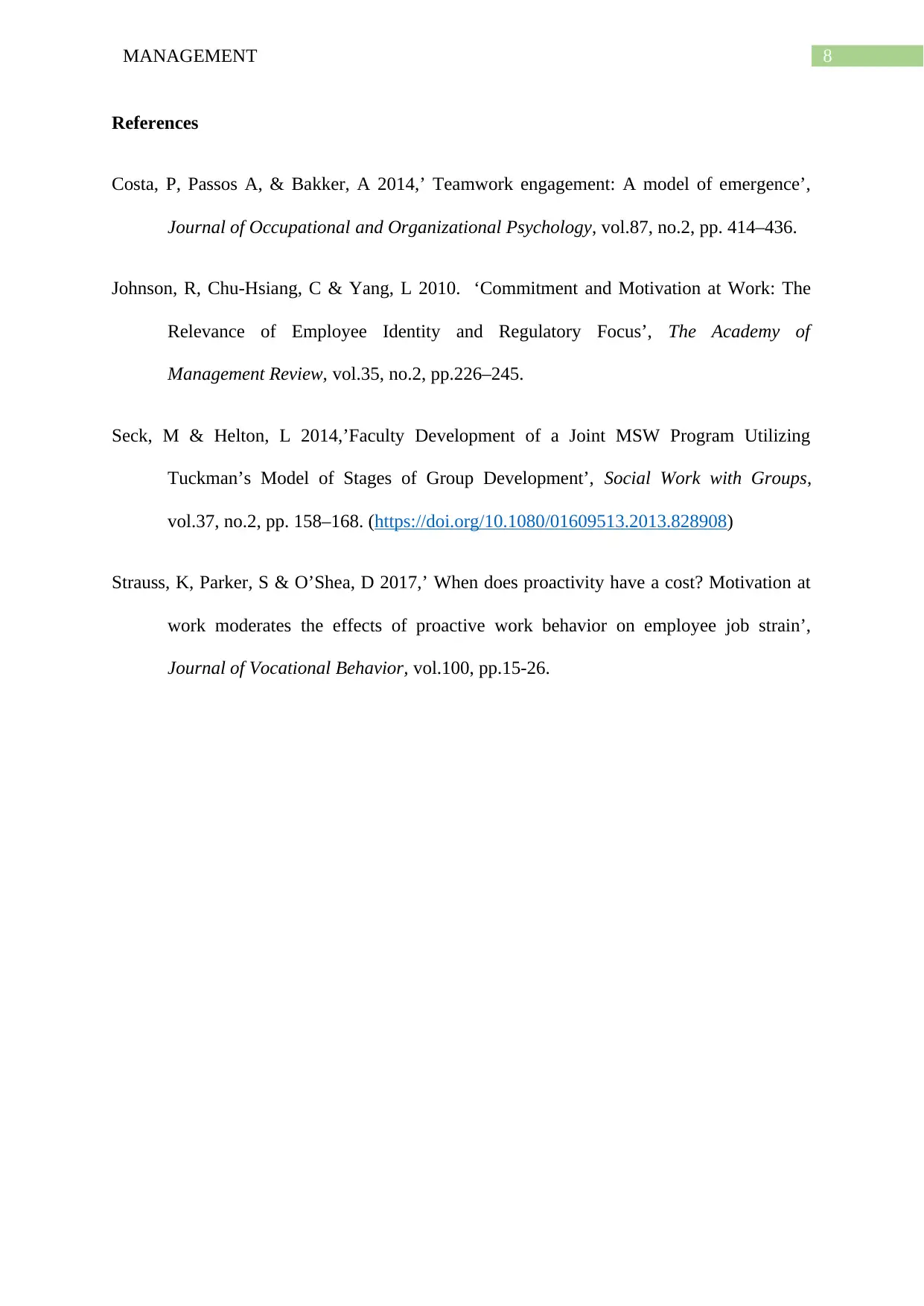
8MANAGEMENT
References
Costa, P, Passos A, & Bakker, A 2014,’ Teamwork engagement: A model of emergence’,
Journal of Occupational and Organizational Psychology, vol.87, no.2, pp. 414–436.
Johnson, R, Chu-Hsiang, C & Yang, L 2010. ‘Commitment and Motivation at Work: The
Relevance of Employee Identity and Regulatory Focus’, The Academy of
Management Review, vol.35, no.2, pp.226–245.
Seck, M & Helton, L 2014,’Faculty Development of a Joint MSW Program Utilizing
Tuckman’s Model of Stages of Group Development’, Social Work with Groups,
vol.37, no.2, pp. 158–168. (https://doi.org/10.1080/01609513.2013.828908)
Strauss, K, Parker, S & O’Shea, D 2017,’ When does proactivity have a cost? Motivation at
work moderates the effects of proactive work behavior on employee job strain’,
Journal of Vocational Behavior, vol.100, pp.15-26.
References
Costa, P, Passos A, & Bakker, A 2014,’ Teamwork engagement: A model of emergence’,
Journal of Occupational and Organizational Psychology, vol.87, no.2, pp. 414–436.
Johnson, R, Chu-Hsiang, C & Yang, L 2010. ‘Commitment and Motivation at Work: The
Relevance of Employee Identity and Regulatory Focus’, The Academy of
Management Review, vol.35, no.2, pp.226–245.
Seck, M & Helton, L 2014,’Faculty Development of a Joint MSW Program Utilizing
Tuckman’s Model of Stages of Group Development’, Social Work with Groups,
vol.37, no.2, pp. 158–168. (https://doi.org/10.1080/01609513.2013.828908)
Strauss, K, Parker, S & O’Shea, D 2017,’ When does proactivity have a cost? Motivation at
work moderates the effects of proactive work behavior on employee job strain’,
Journal of Vocational Behavior, vol.100, pp.15-26.
⊘ This is a preview!⊘
Do you want full access?
Subscribe today to unlock all pages.

Trusted by 1+ million students worldwide
1 out of 9
Related Documents
Your All-in-One AI-Powered Toolkit for Academic Success.
+13062052269
info@desklib.com
Available 24*7 on WhatsApp / Email
![[object Object]](/_next/static/media/star-bottom.7253800d.svg)
Unlock your academic potential
Copyright © 2020–2025 A2Z Services. All Rights Reserved. Developed and managed by ZUCOL.





